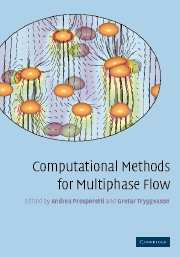Book contents
- Frontmatter
- Contents
- Preface
- Acknowledgments
- 1 Introduction: A computational approach to multiphase flow
- 2 Direct numerical simulations of finite Reynolds number flows
- 3 Immersed boundary methods for fluid interfaces
- 4 Structured grid methods for solid particles
- 5 Finite element methods for particulate flows
- 6 Lattice Boltzmann models for multiphase flows
- 7 Boundary integral methods for Stokes flows
- 8 Averaged equations for multiphase flow
- 9 Point-particle methods for disperse flows
- 10 Segregated methods for two-fluid models
- 11 Coupled methods for multifluid models
- References
- Index
6 - Lattice Boltzmann models for multiphase flows
Published online by Cambridge University Press: 07 December 2009
- Frontmatter
- Contents
- Preface
- Acknowledgments
- 1 Introduction: A computational approach to multiphase flow
- 2 Direct numerical simulations of finite Reynolds number flows
- 3 Immersed boundary methods for fluid interfaces
- 4 Structured grid methods for solid particles
- 5 Finite element methods for particulate flows
- 6 Lattice Boltzmann models for multiphase flows
- 7 Boundary integral methods for Stokes flows
- 8 Averaged equations for multiphase flow
- 9 Point-particle methods for disperse flows
- 10 Segregated methods for two-fluid models
- 11 Coupled methods for multifluid models
- References
- Index
Summary
Brief history of the lattice Boltzmann method
In recent years, the lattice Boltzmann method (LBM) (Chen and Doolen, 1998; Succi, 2001) has become a popular numerical scheme for simulating fluid flows and modeling physics in fluids. The lattice Boltzmann method is based on a simplified mesoscopic equation, i.e. the discrete Boltzmann equation. By starting from mesoscopic modeling, instead of doing numerical discretizations of macroscopic continuum equations, the LBM can easily incorporate underlying physics into numerical solutions. By developing a simplified version of the kinetic equation, one avoids solving complicated kinetic equations such as the full Boltzmann equation. The kinetic feature of the LBM provides additional advantages of mesoscopic modeling, such as easy implementation of boundary conditions and fully parallel algorithms. This is arguably the major reason why the LBM has been quite successful in simulating multiphase flows. Furthermore, because of the availability of very fast and massively parallel computers, there is a current trend to use codes that can exploit the intrinsic features of parallelism. The LBM fulfills these requirements in a straightforward manner.
The lattice Boltzmann method was first proposed by McNamara and Zanetti in 1988 in an effort to reduce the statistical noise in lattice gas automaton (LGA) simulations (Rothman and Zaleski, 2004). The difference is that LBM uses real numbers to count particle population, while LGA only allows integers. The result has been phenomenal: the lattice Boltzmann model substantially reduced the statistic noise observed in LGA simulations.
- Type
- Chapter
- Information
- Computational Methods for Multiphase Flow , pp. 157 - 192Publisher: Cambridge University PressPrint publication year: 2007
- 2
- Cited by

